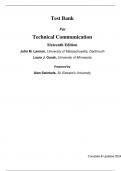Test Bank
For
Technical Communication
Sixteenth Edition
John M. Lannon, University of Massachusetts, Dartmouth
Laura J. Gurak, University of Minnesota
Prepared by
Alan Swinkels, St. Edward’s University
Complete & Updated 2024
,______________________________________________________________________________
Copyright © 2025, 2020, 2017 by Pearson Education, Inc. or its affiliates. All Rights Reserved. This publication is
protected by copyright, and permission should be obtained from the publisher prior to any prohibited reproduction,
storage in a retrieval system, or transmission in any form or by any means, electronic, mechanical, photocopying,
recording, or otherwise. For information regarding permissions, request forms, and the appropriate contacts within
the Pearson Education Global Rights & Permissions Department, please visit www.pearsoned.com/permissions/.
Complete & Updated 2024
,CONTENTS
PART 1 COMMUNICATING IN THE WORKPLACE
Chapter 1 Introduction to Technical Communication 1
Chapter 2 Meeting the Needs of Specific Audiences 4
Chapter 3 Persuading Your Audience 7
Chapter 4 Weighing the Ethical Issues 10
Chapter 5 Teamwork and Global Considerations 13
Chapter 6 An Overview of the Technical Writing Process 16
PART 2 THE RESEARCH PROCESS
Chapter 7 Thinking Critically about the Research Process 19
Chapter 8 Evaluating and Interpreting Information 22
Chapter 9 Summarizing Research Findings and Other Information 25
PART 3 ORGANIZATION, STYLE, AND VISUAL DESIGN
Chapter 10 Organizing for Readers 28
Chapter 11 Editing for a Professional Style and Tone 31
Chapter 12 Designing Visual Information 34
Chapter 13 Designing Pages and Documents 37
PART 4 SPECIFIC DOCUMENTS AND APPLICATIONS
Chapter 14 Email, Texts, and Instant Messaging 40
Chapter 15 Workplace Memos and Letters 43
Chapter 16 Résumés and Other Job-Search Materials 46
Chapter 17 Technical Definitions 49
Chapter 18 Technical Descriptions, Specifications, and Marketing Materials 52
Chapter 19 Instructions and Procedures 55
Chapter 20 Informal Reports 58
Chapter 21 Formal Analytical Reports 61
Chapter 22 Proposals 64
Chapter 23 Presentations and Video Conferencing 67
Chapter 24 Web Pages and Social Media 70
3
Copyright © 2025, 2020, 2017 Pearson Education, Inc. All rights reserved.
Complete & Updated 2024
, PART 1—COMMUNICATING IN THE WORKPLACE
CHAPTER 1 – Introduction to Technical Communication
True or False Questions
1. _____ Technical communication rarely focuses on the author’s personal thoughts or feelings.
2. _____ Few technical documents have a persuasive purpose.
3. _____ Phone calls, conversations, and meetings have largely replaced the need for written
documents.
4. _____ Most technical writing is done in teams.
5. _____ All documents have some persuasive aspect, even if the persuasion is implicit.
6. _____ Technical writers cannot be held responsible for faulty information, but the companies
they
work for can.
7. _____ A technical communicator might be called an information architect, technical editor, or
content developer.
8. _____ Digital communication is the universal global standard for technical communication.
Fill-In-The-Blank Questions
9. ________________ - centered documents focus on what people need to learn, do, or decide.
10. Communication and critical thinking are examples of __________________ skills.
11. Most technical documents are intended to persuade, inform, or ___________________.
Multiple Choice Questions
12. Which document provides an example of technical writing primarily intended to persuade?
(a) a grant proposal to obtain funding from a community agency
(b) a training manual for coffee shop employees for making different drinks
(c) instructions for assembling a desk
4
Copyright © 2025, 2020, 2017 Pearson Education, Inc. All rights reserved.
Complete & Updated 2024




